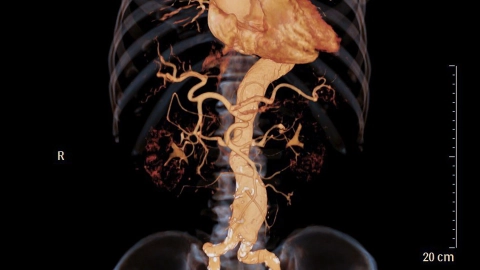ICD-Code I71.4: Abdominal aortic aneurysm, without mention of rupture
Your aorta has expanded.
The aorta carries the blood from the heart to the body. Your aorta is wider than normal. This can occur, for example, when someone has persistent high blood pressure, or if the vascular wall weakens.
The aorta begins at the heart itself. First it runs upwards and then it arches down through the chest to the abdomen. At around the level of the navel, the aorta branches into 2 large blood vessels. These blood vessels first run to the pelvis and then to the legs. The wall of the aorta is made up of several thin layers. In your case, the aorta is affected in your abdomen.
You may not at first notice any enlargement of the aorta.
However, blood may also get between the layers of the aortic wall and build up there. As a result, the inside of the aorta can be constricted as can other blood vessels branching out from the aorta. A narrowing of the points where these vessels branch out can mean that not enough blood reaches the internal organs or legs, for example.
If the aorta is enlarged, there is also a risk of the wall of the aorta rupturing. This means that blood can flow into the chest or abdomen. This can be painful and life-threatening.
Additional indicator
On medical documents, the ICD code is often appended by letters that indicate the diagnostic certainty or the affected side of the body.
- G: Confirmed diagnosis
- V: Tentative diagnosis
- Z: Condition after
- A: Excluded diagnosis
- L: Left
- R: Right
- B: Both sides
Further information
Source
Provided by the non-profit organization “Was hab’ ich?” gemeinnützige GmbH on behalf of the Federal Ministry of Health (BMG).

